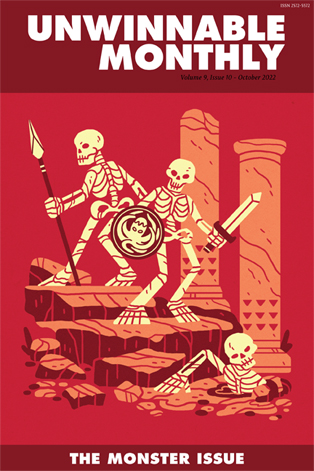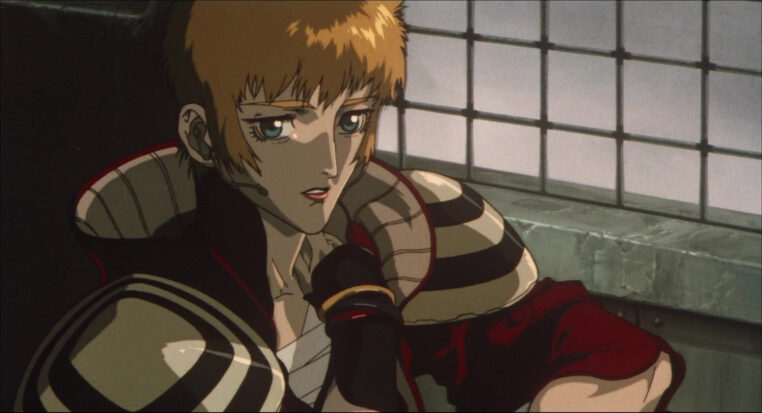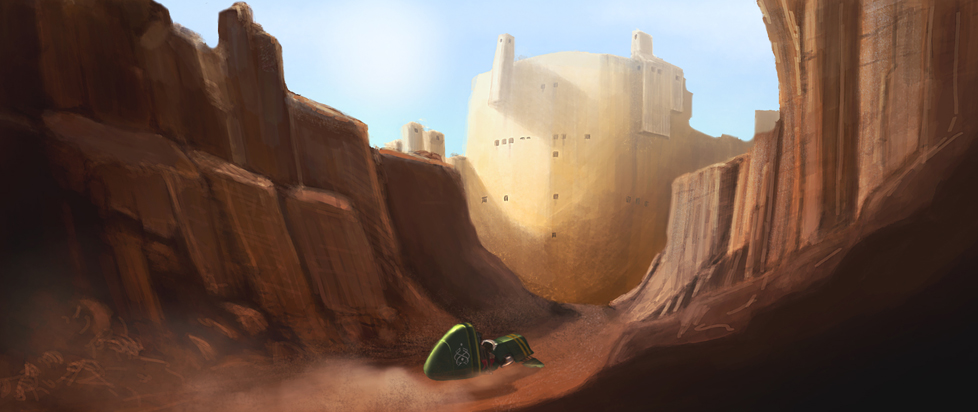
Half-Humans and Half-Lives

This column is a reprint from Unwinnable Monthly #156. If you like what you see, grab the magazine for less than ten dollars, or subscribe and get all future magazines for half price.
———
Analyzing the digital and analog feedback loop.
———
There’s some dialogue from the anime film Vampire Hunter D: Bloodlust (the English dub version) that’s burrowed its way into me over the years and made a home there. For those who haven’t watched it before, it’s an adaptation of one of Kikuchi Hideyuki’s famous novels, about a character who is described in the title sequence as a vampire “hunter unlike all the others.” He’s a Dhampir or, in plain terms, a half human, half vampire. How D is characterized as a Dhampir in the film is actually fairly close to the original folklore. He is the son of the union between a human woman and a male vampire, who makes his living as a vampire hunter because he’s preternaturally-suited for the position.
In this particular adventure, D is hunting down Meier Link, a vamp of the most powerful order – the Nobles, who has kidnapped a human woman named Charlotte Elbourne. D is not the only hunter hired by the Elbournes to retrieve her and dispose of Meier, however. The Elbournes also hired a group of human vampire hunters to ensure the job gets done. Naturally, a rivalry forms between both parties. A further complication arises early in the mission: Charlotte doesn’t want to be rescued and cares deeply for Meier, one of the last of his kind. D’s iconic left hand, which is host to a symbiotic demon face, suspects that D’s motivations for hunting Meier are rooted in a fear that Charlotte might eventually give birth to another Dhampir, like him. So, at the throbbing heart of this vampire tale is a fear of different beings mixing to create (in the eyes of this fictional world) a monstrous being. And forbidden love.
With this context in mind, here is the aforementioned dialogue/scene. Leila, the human vampire bounty hunter, has crossed paths more than once with D, the half-vampire or Dhampir bounty hunter, at this point of the movie. The two have saved each other’s lives, D having previously bandaged Leila’s wound from a close encounter with Meier Link and Leila having dug a temporary grave for D when he’s struck down with sun-sickness (one of his only weaknesses other than bloodlust as a Dhampir) during another battle with one of Link’s hired demon bodyguards, called Barbaroi. Subsequently, the two have now progressed far enough in their “enemies to… perhaps friends?” arc that Leila opens up about her backstory when prompted by D – how her mother was kidnapped like Charlotte was, how she was turned into a vampire and killed by the village Leila’s family lived in. This event set Leila on her path to become a vampire hunter. She then suggests they make a pact with one another since they’ve trauma-bonded over their shared line of work and their loneliness. The pact is simple yet heartfelt, whoever dies first, the one left behind will bring them flowers to their grave. While Leila falters and believes she’s being overly sentimental for suggesting it, D cuts her off belying his usual stoic demeanor with earnest and determined acceptance of the pact:
D: I’ll do it. I’ll bring you flowers if I survive this – but I don’t expect to.
Leila: Stop, I didn’t really mean it when I said that. And anyway, I don’t really understand why you should keep on doing this.
D: Because I’m a dhampir. I don’t get to have a life; not like you.
D’s last line in this scene, in particular, struck me. On the one hand, it’s pretty straightforward, no one wants to be an immortal yet unliving creature like a Dhampir. And throughout the film many characters express their intimidation or hatred of D’s existence. But on the other hand, the subtext took me aback as someone who is of mixed heritage. Being someone who is neither wholly one category of being or another, D is condemned to a between place in his world. He is a being that is considered unnatural and monstrous, or at least less than human, because he’s mixed. His father in fact was the Vampire King. In addition, at least in the world of the film (I don’t have much experience with the series except for reading the first translated novel a long time ago), D is the only Dhampir around. The Japanese script is somewhat different, but emphasizes the same points, although it’s noteworthy that Leila’s lead up to the pact is a lot more barbed, comparing D to Noble vampires who are “less than animals” and that he’s “just like them.”
Of course, it’s important to note that one must consider this half-human character’s representation within the context of the culture that created him. In Japan, the population is mostly homogenous and although there are a relative number of foreigners and half-Japanese people (called “hafus”) living there, the number pales in comparison to the amount of Japanese-descent people. According to a video interview by Asian Boss , 98 per cent of the country’s people are ethnically Japanese, which means foreigners and those who appear phenotypically foreign stick out. An equally interesting and frustrating social dynamic results from this.

Some half-Japanese people visibly pass as Japanese, until they are found to be lacking in Japanese language or culture fluency. Other half-Japanese people, especially those who are dark-skinned, are often immediately subjected to racism but often surprise the public when they are native Japanese speakers or understand the country’s customs. Some recent high-profile cases of this discrimination are Miss Universe Japan 2015’s Ariana Miyamoto and tennis grand slam singles winner Naomi Osaka. Regarding Miyamoto in particular, she entered the Miss Japan contest in honor of a multiracial friend who committed suicide due to the pressure of being unaccepted in Japan.
Although interracial families in Japan are more common today, there is still a debate about whether those considered hafu will ever be accepted as part of Japanese society. This ambivalence is shown even in the description of a recent documentary on the hafu population, which mentions some hafus feel “caught somewhere between two different worlds.” As well, it’s an ongoing issue that discrimination of hafu people often goes unnoticed or ignored in part because they are not considered a distinct ethnic group (legally or otherwise) in Japan. To tie this back to D’s characterization, the Dhampir shares certain features with Noble vamps like Meier (deathly pale skin, pointy ears and fangs). Yet characters both human and vampiric recognize him on sight as a Dhampir and condemn him often for it. This condemnation could also be due to his reputation as the lone hunter. In other words, D cannot “pass” as a human or a pureblooded vampire, emphasizing his position as a figure that is caught in-between.

D’s pact with Leila is not wholly tragic, however. In making such a pact of friendship, despite Leila’s history with vampires, the two find common ground as individuals. They put aside their differences to do their best to make their world a safer place, even though doing so as hunters means either of them likely will be killed by their calling. Throughout the movie, we learn that Charlotte and Meier also made a pact with each other to find a way to “the kingdom at the end of the stars”, and that she wasn’t so much kidnapped as she was eloping with him. This last point may be up for debate, as this could also be explained away as Stockholm syndrome. Still, there are enough scenes showing the two’s mutual respect for one another and Meier’s reluctance to turn Charlotte that perhaps she truly did want to elope with him. And although I’m focusing on the English dub of this film, it’s worth noting that in the Japanese script D mentions early on that despite Meier being a Noble vampire (who are usually known for treating humans like chattel to be slaughtered as needed or on a whim) he has a reputation for never using his fangs on humans. The movie seeks at least some nuance regarding themes of how prejudice and intergenerational trauma affect people.
I remain conflicted about what I took from Bloodlust’s subtext however. D’s character strikes me as somewhat of a tragic mixed-race stereotype, someone condemned to a purgatorial state because of mixing. I can’t help but think of the term that preceded miscegenation, amalgamation. Both are archaic American epithets for interracial relationships, but the latter was derived from the metallurgic term for mixing metal with mercury. Interracial relations have a long history of being treated by systemic racism as a kind of unholy alchemical act, mixing one supposedly stable or pure category with another less predictable and toxic category. As writer Esi Edugyan puts it in her exploration of race and storytelling Out of the Sun, “The story of miscegenation is the story of the blood’s corruption, of damaging one’s name and one’s line through taint.” The fact that D’s very existence is described as monstrous and that D himself possibly fears another like him being born carries similar fears underscoring narratives like Birth of a Nation, in which interracial relationships was a central tension, or which inspired writers like H.P. Lovecraft for him miscegenation was a terror of cosmic proportions.

He is also even when viewed with a more positive lens dangerously close to being an example of an interracial figure who “solves racism” simply by existing against all odds and being an example of a rare virtuous Other. Although I think D is meant sometimes to be more of a potential bridge than a role model. Near the climax of the film at Carmilla’s hallucinatory Castle Chaythe for instance, D confronts an illusion of his human mother lamenting that he must hate her for falling in love with his father, the vampire king, but that she couldn’t help who she fell for. In a behind-the-scenes featurette, director Kawajiri Yoshiaki states that because D is half vampire and half human “he has an evil side and a good side. He is extremely beautiful and extremely tough.” Kikuchi has been quoted more than once as having conceived D as someone who’s beauty is enhanced because he’s a Dhampir. This makes D something of an exotic Other, someone both desired and despised. A figure that inspires the infuriating question “what are you?” at every turn. The stable scene where D is confronted at gunpoint by the sheriff and his men and told to leave town because they don’t sell to Dhampirs is also very charged in this sense.
Having lost his cyborg horse in a fight with Benge, another of the Barbaroi, D visits a local stable to buy another steed from the gruff old mechanic Polk. Although Polk quotes him a steep three grand and tells him that if he doesn’t like the price he can “go somewhere else,” he stands up for D when he faces aggressive discrimination by the sheriff and crew, levelling a large weapon he was working on at the men. It turns out Polk is someone D saved when he was a child along with ten other children who were kidnapped by vamps. He remembers how D was violently run out of town and tells the sheriff “I would much rather be an old fool than what you are, sheriff” before thanking D for what he did for him and noticing that D has remained as beautiful and young as he appeared all those years ago. I found it odd that they excised Polk’s line “It’s not by choice that Dhampirs have the Nobles’ blood.” from the Japanese script here. But the scene’s tone remains fairly unchanged.
Overall, I think Bloodlust’s moral ambiguity suits it as a Gothic tale about a post-apocalyptic sci-fi and cowboy western-inspired world. I don’t believe that there’s necessarily ill-intentions regarding how a Dhampir like D is depicted. But I do think there are often troubling parallels between the tropes being half-human and the tropes of being mixed or multiracial. These parallels often go unmentioned and seemingly unexamined in the making of this film. The way D is portrayed is not unique to Japanese media, although this template for purgatorial mixed background characters continues on with characters like Castlevania’s Alucard and Devil May Cry’s Dante, Vergil and Nero. In the case of recent characters whose purgatorial nature is made very literal, there is Zagreus of Hades (a figure I could spend another whole column musing on). I’d love for there to be more characters like Aveline of Assassin’s Creed: Liberty, who consciously recognize and subvert mixed racial tropes.
Dhampirs may be characterized as monstrous because they’re mixed, but they also highlight how constructed and systemic perceptions of race are. The fact that even D’s world is a mixed one, both past and future combined in the sci-fi horror mashup Kikuchi has created is telling, an extended projection of D’s inner existential fragmentation. Vampire Hunter D: Bloodlust expertly underscores the fear of the unknown, and since Dhampirs are caught in a twilight world between human and vampiric existence they epitomize that fear.
———
Phoenix Simms is a writer and indie narrative designer from Atlantic Canada. You can lure her out of hibernation during the winter with rare McKillip novels, Japanese stationery goods, and ornate cupcakes.




